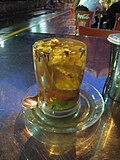| Ginger tea | |
|---|---|
 | |
| Type | Herbal tea |
| Other names |
|
| Origin | Asia |
| Quick description | Tea made from ginger |
| Temperature | 100 °C (212 °F) |
| Time | Varies |
| Regional names | |||||||||||||
|---|---|---|---|---|---|---|---|---|---|---|---|---|---|
| Chinese name | |||||||||||||
| Traditional Chinese | 薑母茶 | ||||||||||||
| Simplified Chinese | 姜母茶 | ||||||||||||
| Literal meaning | ginger mother (mature ginger) tea | ||||||||||||
| |||||||||||||
| Korean name | |||||||||||||
| Hangul | 생강차 | ||||||||||||
| Hanja | 生薑茶 | ||||||||||||
| Literal meaning | ginger tea | ||||||||||||
| |||||||||||||
| Japanese name | |||||||||||||
| Kanji | 生姜湯 | ||||||||||||
| Kana | しょうがゆ | ||||||||||||
| |||||||||||||
| Malay name | |||||||||||||
| Malay | teh halia | ||||||||||||
| Indonesian name | |||||||||||||
| Indonesian | teh jahe | ||||||||||||
| Filipino name | |||||||||||||
| Tagalog | salabat | ||||||||||||
Ginger tea is a herbal beverage that is made from ginger root. It has a long history as a traditional herbal medicine in East Asia,South Asia,Southeast Asia,and West Asia. [1]











